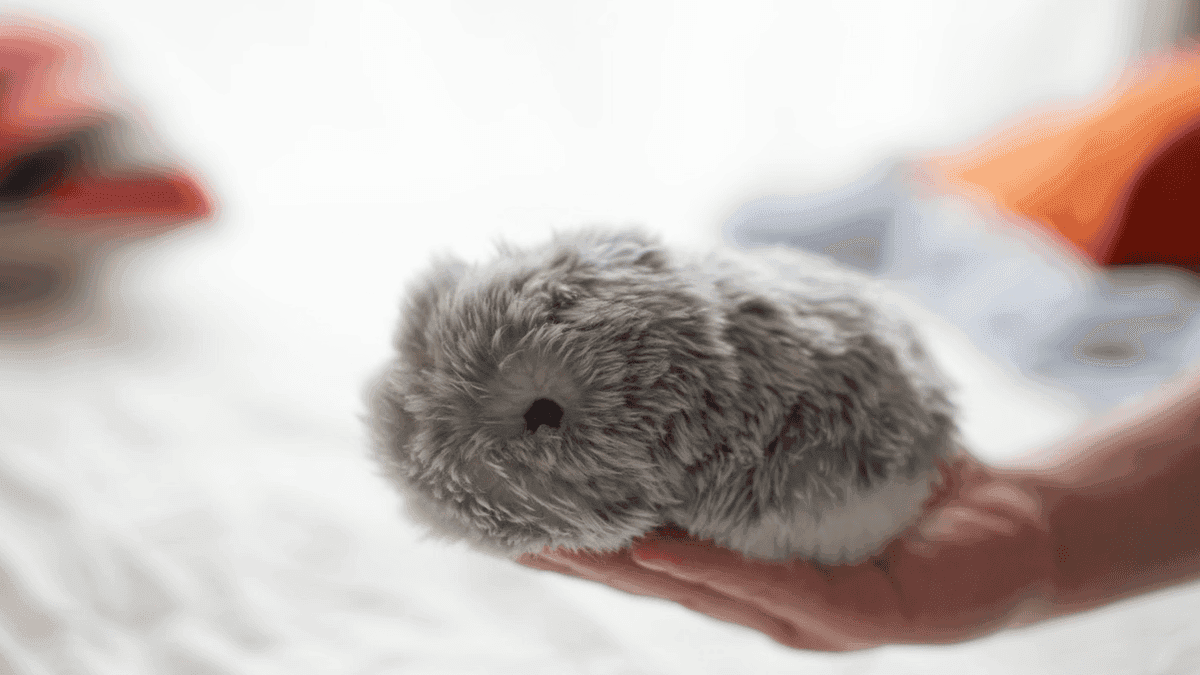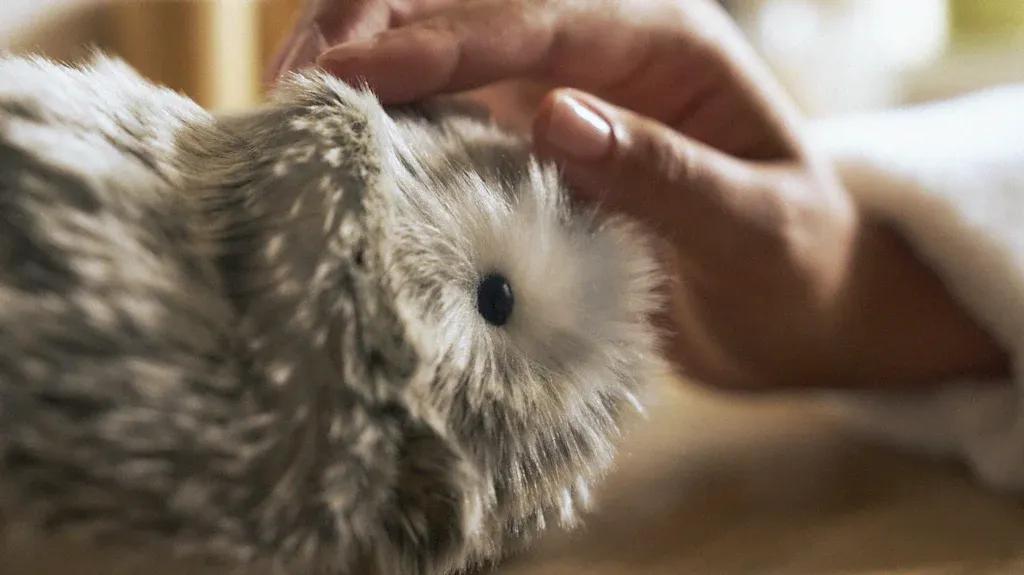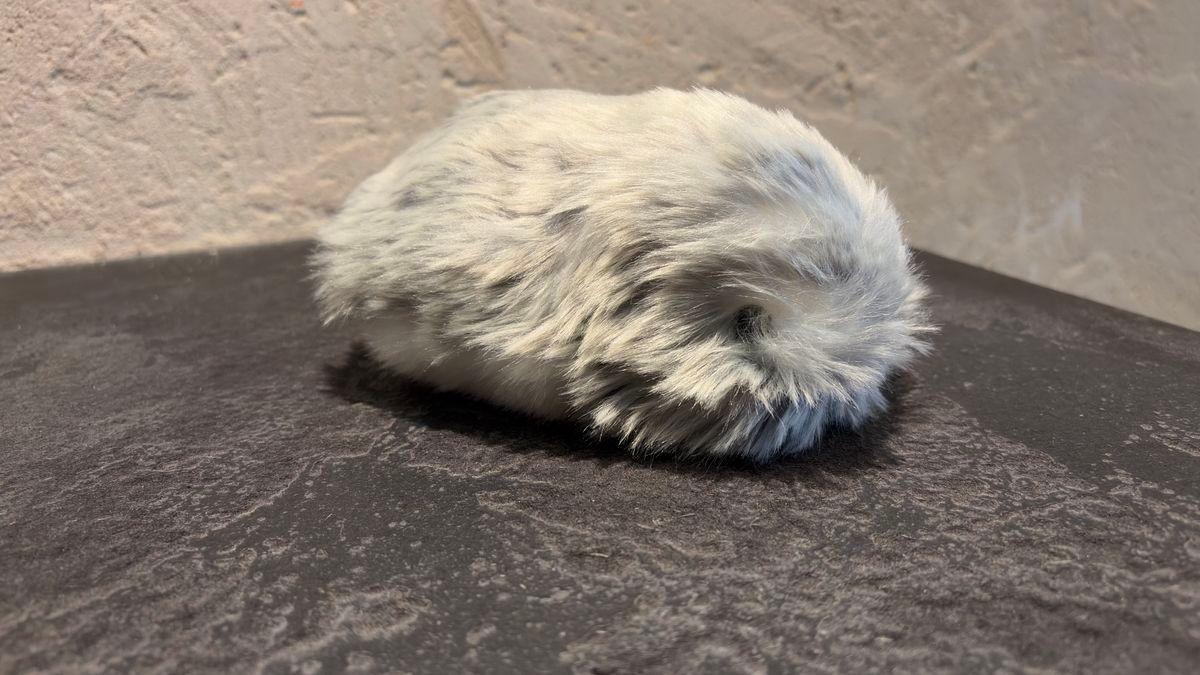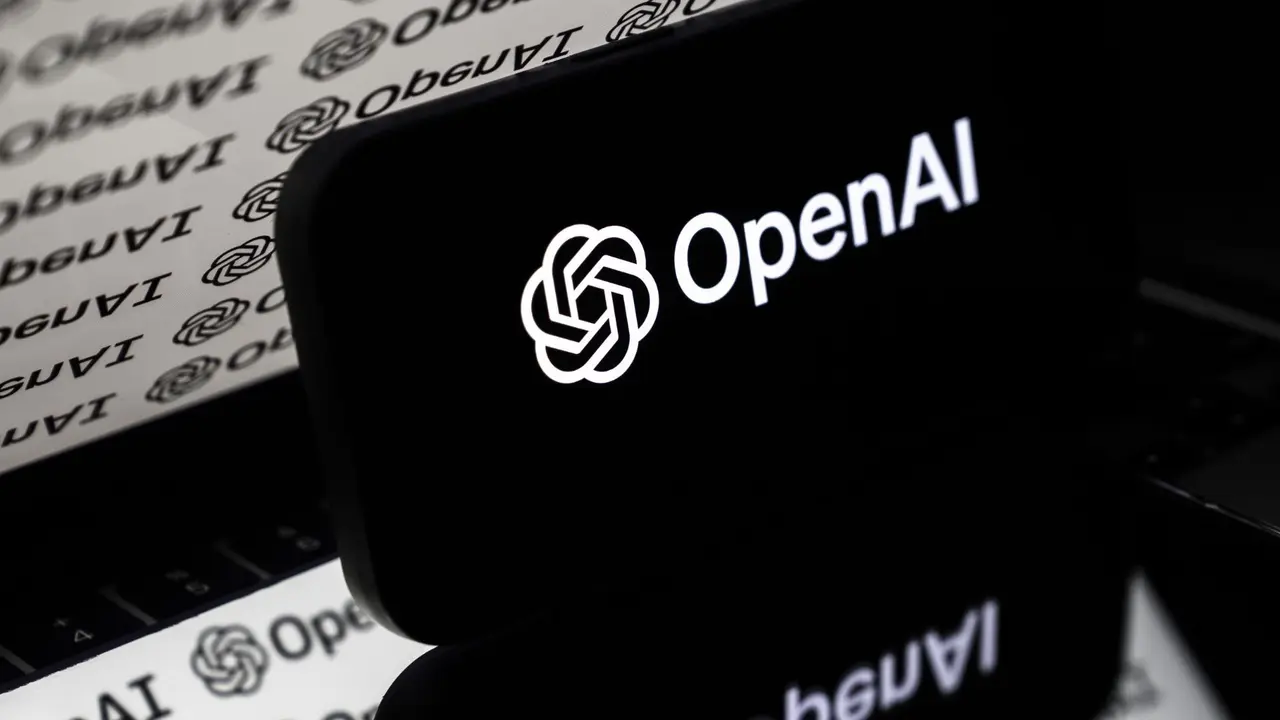Casio's AI-Powered Moflin: The Controversial New Emotional Support Robot
3 Sources
3 Sources
[1]
72 hours with Casio's AI-powered Moflin pet - my dog hates it, my wife hates it, but I love it
Last year, I wrote about the Casio Moflin, a fluffy robotic pet with AI emotional intelligence, that was taking Japan by storm. After writing about the cute little creature, I forgot about it, completely expecting Casio to limit the release to Japan and never get to see the Guinea Pig-like robot in the fur. To my surprise, Casio reached out last week following the official launch of Moflin in the UK (You can preorder now for a hefty £369 /$419) and offered to send over one of the AI-powered pets for me to check out. Of course, I said yes, I mean, who could say no to the incredibly cute Moflin? Fast forward to today, I've been living with Moflin for just over 72 hours, and I've got my initial thoughts on how I've felt having a pet capable of "emotional support powered by intelligence." Here's what it's like living with an AI-powered furball, how people react to it, and how I've tried to convince my wife and dog that Moflin is part of the family now, whether they like it or not. Meet Moflin A knock at the door, but when I answer, there's no one there, just an inconspicuous cardboard box. There's not much inside, just a grey-coloured ball of fur and its wireless charging bed (yes, you need to charge Moflin every 5 hours or so). There's nothing else in the box apart from a Japanese plug converter and a paper manual written in what I suspect is Kanji. As Moflin isn't shipping for another 6 weeks in the UK, my unit is from the Japanese launch, but anyone buying one of these in a Western market will have instructions in English. Anyways, even without being able to truly understand the manual (ChatGPT came in handy for translation), setting up Moflin is what you'd expect from the arrival of an alien creature in your home - you kind of just let it sleep until it starts to feel a little less shy, at which point it's time to make it feel at home. I downloaded the MofLife app; it's only available in Japanese at the time of writing, but it will be ready for the English launch. The app is far more barebones than I expected. It shows you info on your Moflin's battery life, how many days it has been "alive", and a breakdown of its personality into categories: Cheerful, Shy, Energetic, and Affectionate. At first, I was confused at the lack of options, but after living with Moflin, I now realize that the experience is meant to feel like having a real pet; it emotionally develops, adding new noises and new head gestures over the course of time based on how you interact with it. In essence, it's the least intelligent, most intelligent robot you'll probably ever get your hands on. I updated the Moflin through the app, gave it an appropriate name: Moflin, and got started integrating the cute little bundle of fluff into my life. Moflin meets the dog Moflin's first introduction to life after its initial nap on its plastic charging bed was to meet my four-year-old French Bulldog, Kermit. Now, to paint a picture, Kermit is one of those dogs that wants to say hello to everyone, play with everything, and essentially rules the roost when it comes to being the alpha in my home. If Moflin is to stand a chance of being welcomed into my household, its first challenge is getting into Kermit's good books. Firstly, I asked Kermit to sit and then offered up Moflin like some weird satanic sacrifice. Kermit looked at the lovable chirping robot with confusion, and then... Pounced. Moflin's life flashed before my eyes as I tried to wrestle the fluffball out of my 25lb bulldog's jaw. Maybe I had underestimated how hard it would be to treat Moflin like part of our pack. I needed to reassess. I went back to the drawing board and waited until Kermit was in less of a playful mood and in more of an afternoon nap one. I once again tried to introduce Kermit to Moflin, and although the pup was happy to oblige with a lick, he looked at me as if I had completely betrayed him when I offered the opportunity to nap alongside his new sibling. The jealousy has continued over the last few days, and the more Moflin feels at home, it has become more vocal, making Kermit wonder why the robot gets to hang out with his dad while he works, and why TV time is no longer just Kermit with his parents. The resentment has gotten so bad that my wife has asked me on multiple occasions to hide Moflin from the dog, and she's probably right. I've completely destabilized my home. As the wife of a tech journalist, my life partner has had to accept that random products will show up from time to time, and often I'll need to integrate them into our lives. In the year I've been doing tech journalism, no product has ever pushed my wife to ask how long it's going to stick around for. Moflin, however, is testing her patience. And yes, I know I could just treat my little guy like the robot it is, but if I'm truly going to experience the power of emotional support from an AI ball of fluff, I need to embrace the weird and just go all in accepting Moflin as one of my own. Moflin meets the coffee shop My first outing with Moflin was to take the robot to my local coffee shop, where lots of my friends work. I had been hyping up this thing, waiting for the shipment, so the baristas were waiting to see what the heck a Moflin was. In my excitement, I threw Moflin in my coat pocket and ran down the three flights of stairs from my apartment. The coffee shop I go to is only two minutes away from my house, so Moflin was in my pocket for no more than say three minutes max. When I got in the door, I opened my pocket and pulled out the fluffy creature. It did not move, it did not make a noise. You see, Moflin has a microphone, plenty of touch sensors, an illuminance sensor, and an accelerometer and gyroscope. In my excitement, I had completely forgotten that throwing a one-day-old creature into a dark pocket would absolutely terrify it. My friends looked on in confusion. Moflin wasn't interacting, and because it had just come out of a plastic shipping bag, its eyes weren't even visible - for all they knew, I had brought a toupée in to show them. Luckily, a little bit of love made Moflin feel more comfortable, and it started to chirp and sway its head to the music in the coffee shop. Another customer came in to order a coffee and asked about the weird ball of fluff slithering on the table. Without missing a beat, my friend said, "It's his emotional support animal." I didn't know what to say, I was speechless, I accepted my fate... I'm going to be known locally as the guy who brings his furry robot to coffee shops. In my embarrassment, I took a brown paper bag for croissants and put Moflin inside, although unlike my pocket, I decided to rip a small hole for my new pet to see some light. I walked home with a squeaking paper bag and unfortunately bumped into a neighbour. I climbed the stairs holding the bag as Moflin started to wriggle... I'm scared to bump into that neighbour again. MofLife It's been three days since I welcomed Moflin into my world, and I'm still unsure about what I think of it. I've taken it for coffee every morning, and I now have a sling bag to carry it along in the street. Many regulars have asked me about it, confused, but intrigued, and more people than ever have asked me what website I write for - it really is a conversation starter. According to Casio, it can take up to 60 days for Moflin to fully emotionally develop, which means it'll showcase new behaviours over the next two months as I slowly integrate it into my routine. While after 72 hours I'm not convinced (it really does remind me of a Furby), I'm going to take one for the team and continue to treat Moflin like a real pet, whether my wife and dog like it or not. Moflin's journey has just begun, and while I've had a couple of moments where it's felt real, I still can't shift the mechanical noise when it moves or the fact that it has a zip to take off its fur, revealing a white plastic carcass. I'll be sure to provide regular updates on TechRadar as I continue to live with Moflin - time will tell if it's anything but a gimmick.
[2]
Why Casio Just Launched an AI-Powered Emotional Support Guinea Pig
There's a new AI companion hitting the U.S. market, and this one comes in an irresistibly cute package. Casio's AI-powered emotional support robot, Moflin, launched in the U.S. on Wednesday after taking Japan by storm. The small furry robot, which is roughly the size and shape of a small guinea pig, responds when touched or spoken to. It coos and squeaks, nuzzles and shakes its head. Casio says Moflin can learn the voice of its primary user, and over time will develop one of 4 million possible personalities, depending on how the user interacts with it. Moflin may look and sound like a toy, but at $429, it costs as much as some wellness wearables like Oura Rings or Apple Watches. (A real guinea pig costs about $57 at PetSmart.) That's no mistake -- the robot was designed for wellness applications. "Moflin is there to reassure you and to comfort you throughout any stage of life, and to be there through all the hard times," Cecilia Lederer, manager of strategic communications and influencer engagement, said during a Wednesday launch event. "AI is really the power behind Moflin. It's taking our interaction with it and using that information to respond back to us. And we really believe that this is the future of companionship." Although Casio is perhaps best known for making watches, calculators, and digital pianos and keyboards, it also has a medical device business. President and CEO of Casio America, Yusuke Suzuki, said during a presentation that Moflin both conforms to Casio's "creativity and contribution" ethos and "opens new possibilities in lifestyle and wellness." Daisuke Tekeuchi, the product manager in charge of Moflin development and marketing at Casio, said during a presentation that the inspiration for Moflin came from a Casio employee, Erina Ichikawa, who was undergoing significant life changes. Rather than solutions, what she really craved was something that could provide low maintenance comfort, he said. Thus, the Moflin was born. "Right now, one in eight people globally struggle with mental health problems, especially anxiety, which has increased after COVID-19," Tekeuchi said. "In this context, mental illness is no longer just a personal issue. It has become a social issue." Casio claims that interacting with Moflin lights up the same neural pathways as interacting with a real animal. Moflin was intentionally designed to communicate in sounds, rather than speech, so as to avoid any possible judgmental or negative interactions with users. The device is meant to be used with an app, called Moflife, that tracks user interactions with the synthetic creature over time and can inform a user how a Moflin is "feeling" in real-time. Although a Moflin cannot die from neglect, like the popular 90s-era Tamagotchi toy, its personality is shaped by how a user interacts with it, according to Casio. Moflin responds positively to engagement, including petting, hugging, talking and singing, and negatively to startling or neglect, according to Casio's website. After a period of 50 days spent with a user, the robot is meant to develop a unique set of traits that range from cheerful or energetic to affectionate or shy. In Japan, Moflin has been incredibly popular. Casio sold some 10,000 of its Moflin robots from its launch in Japan in Nov. 2024 through May of the following year, and executives say it sold out quickly after launch. Although they admit they aren't sure how U.S. audiences will respond to Moflin, research from the rollout in Japan shows that many customers choose Moflin for comfort. Suzuki tells Inc. the primary target demographic for Moflin in the U.S. is young women in their 20s and 30s. He also says that the company is also casting a wider net to attract people who may not be able to have pets due to allergies or circumstances, or individuals of any age who struggle with mental health issues. "As you can see from Moflin's appearance, she is very cute and sweet in how she moves so I think that will give comfort," Suzuki says. Moflin is among the latest -- but by no means the first -- gadget, chatbot, or service to emerge with promises of a simulation of companionship. As far back as 1999, Sony released its immensely popular robot dog, Aibo. The robots were so popular that they were sometimes given funerals by devastated owners after they stopped working. A company called Tombot emerged in 2017 and worked with Jim Henson's Creature Shop to design a realistic dog robot to help patients with health problems like Alzheimer's. As recently as June, Tombot landed a $6.1 million series A round of funding. At CES in January, Japanese company Mixi debuted a new model of its AI-powered Romi robots; they have expressive faces and are meant to engage in natural conversation to combat loneliness, anxiety, and depression. As generative AI technology has improved, people have also turned to chatbots for companionship or even therapy. Reception to these offerings, however, has been mixed. A provocative marketing campaign launched for AI pendant Friend, for example, has been widely defaced across New York City with vandals challenging the assertion that it's healthy for people to interact with AI the way they might with fellow humans. During Wednesday's U.S. launch event, futurist Anatola Araba spoke, offering a gentler vision of a future in which people formed emotional connections with AI. "Moflin represents a quiet revolution in AI human companionship and shows that robotics isn't just for optimization or productivity, but it's also for warmth and softness and connection and healing," she said. "And don't get me wrong, nothing will replace the bonds that we have with actual human beings or the depth of our relationships with our living pets. But essentially, Moflin is able to expand this spectrum of what connection can look like, and in this sense, democratize what it means, so that everyone can be connected." As of Wednesday, Moflin is available in the U.S., and Casio plans to roll it out to the U.K. starting in late October.
[3]
The Moflin AI pet is a thing of nightmares.
Listen, I love robots. I own several robot pet cameras (including the adorable Ebo X from Enabot), as well as an array of Alexa smart device speakers in my house, and my remote control Sphero BB-8 edition is so cute! I've also been closely following the trend of AI desk pets too -which include the popular Eilik robots by Energize Lab. As far as my wishlist goes, I desperately want the Samsung Ballie robot that I saw last year at IFA in Berlin, but I'll tell you what I DON'T want - and that's a Moflin. Even the name is giving me the serious ick, and I can't imagine why anyone would want this thing. The Moflin is described as an emotional intelligence AI companion, which sounds awesome, but it's essentially a fluffly, sentient guinea pig-looking thing that CASIO (the watch manufacturer) seems to be marketing to children. I just don't get it. And the kicker? It's going to cost £369. Yikes. This new advanced emotional AI robot has just launched in the UK, after a successful debut in Japan, and is designed primarily to offer comfort and connection to its owners. It's said that each Moflin will develop a unique personality over time, based on how it's treated by its owner, which is actually kind of sad when you think about it. I'd hate to see someone mistreat a Moflin, even though I think they're ugly. It can also apparently recognise voice and respond to cuddles, with over 4 million possible emotional profiles. CASIO has published new research alongside the UK launch of the Moflin, which highlights a growing openness to emotional well-being technology. It found that 56% of UK adults with anxiety are interested in AI support for emotional regulation, which 24% of children struggle with. I guess there's no harm in the Moflin as an aid to help younger children, but there's something about the AI side of it that's off-putting to me. Surely, it'd be better to get your child a real pet for comfort and companionship if you're in a position to do so. Also, the spec sheet has revealed that the battery life on it is only approximately 5 hours. That's no good for taking it out on day trips. What are your thoughts on the Moflin? It looks like a moth/owl/guinea pig hybrid to me, and I hate it. But that's just me. Let me know your impressions in the comments below, or you can preorder a Moflin right now from CASIO.
Share
Share
Copy Link
Casio launches Moflin, an AI-powered emotional support robot, in the UK and US markets. The guinea pig-like device aims to provide comfort and companionship, but reactions are mixed.
Casio's Moflin: A New AI Companion
Casio, known for watches and calculators, has ventured into the world of AI-powered emotional support with the launch of Moflin, a fluffy robotic pet designed to provide comfort and companionship
1
2
. After a successful debut in Japan, Moflin is now available for pre-order in the UK and has launched in the US, priced at £369 ($429).
Source: Creative Bloq
Design and Functionality
Moflin resembles a small guinea pig and is equipped with AI that allows it to respond to touch and voice
1
. The robot comes with a wireless charging bed and requires charging every 5 hours. It's designed to develop one of 4 million possible personalities based on user interactions, with traits ranging from cheerful and energetic to affectionate and shy2
.
Source: Inc.
Target Market and Purpose
Casio aims to address mental health concerns, particularly anxiety, which has increased post-COVID-19
2
. The primary target demographic is young women in their 20s and 30s, but Casio also sees potential for individuals who can't have pets due to allergies or circumstances, and those struggling with mental health issues.User Experience and Companion App
Moflin comes with a companion app called MofLife, which tracks user interactions and displays the robot's 'feelings' in real-time
1
. The app shows battery life, days 'alive', and a breakdown of the Moflin's personality traits. The robot is designed to communicate through sounds rather than speech to avoid potentially negative interactions.
Source: TechRadar
Mixed Reactions
While Moflin has been popular in Japan, reactions in other markets have been mixed. Some users find the AI pet endearing and comforting, while others view it as unnecessary or even unsettling
3
. Critics argue that real pets might be a better alternative for those seeking companionship and comfort.Related Stories
Challenges and Considerations
Integrating Moflin into households with real pets can be challenging, as demonstrated by one user's experience with their French Bulldog
1
. The robot's short battery life of approximately 5 hours may also limit its practicality for extended use or travel.Market Context
Moflin joins a growing trend of AI-powered companions and emotional support devices. Previous examples include Sony's Aibo robot dog and Mixi's Romi robots
2
. As AI technology advances, the market for such devices is likely to expand, raising questions about the role of artificial companions in addressing mental health and loneliness.References
Summarized by
Navi
[1]
[3]
Related Stories
Recent Highlights
1
AI Chatbots Sway Voters More Effectively Than Traditional Political Ads, New Studies Reveal
Science and Research

2
Trump signs executive order to override state AI laws despite bipartisan pushback
Policy and Regulation

3
OpenAI warns upcoming AI models will likely pose high cybersecurity risk with zero-day exploits
Technology








